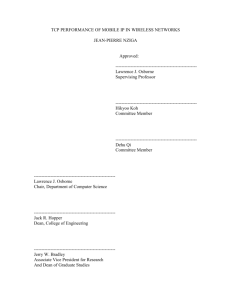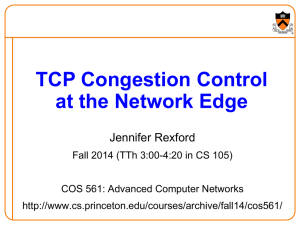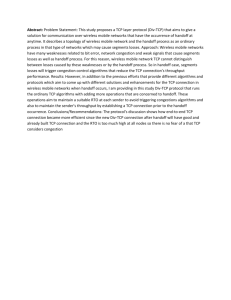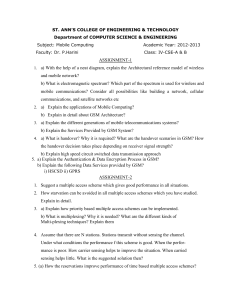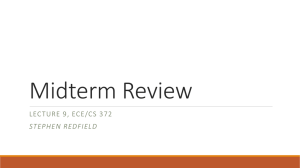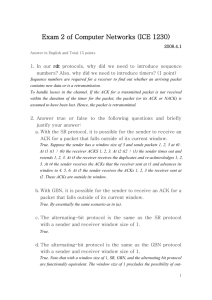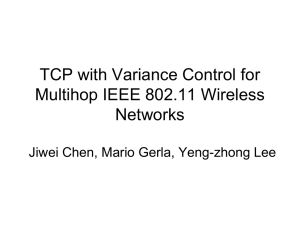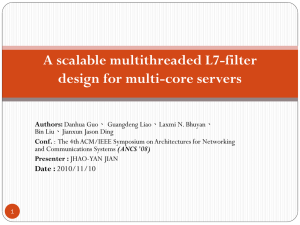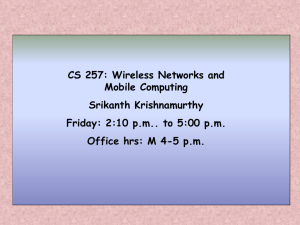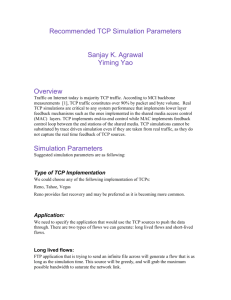M201271785
advertisement
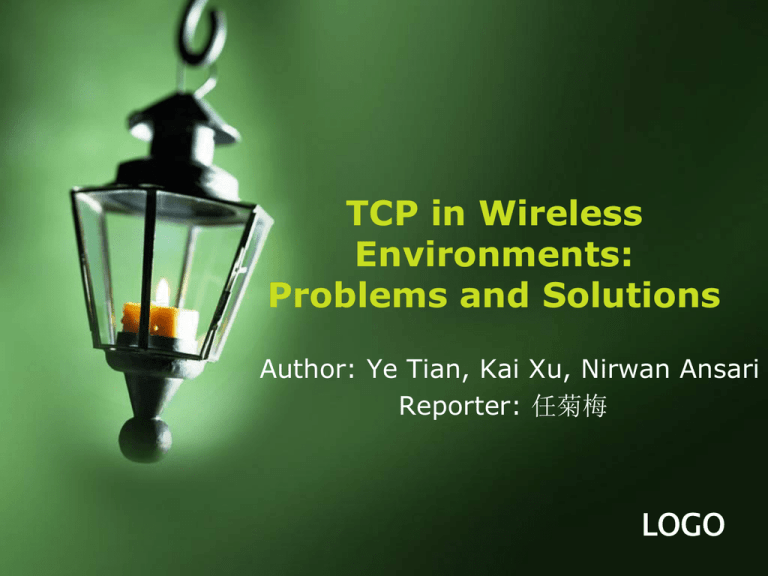
TCP in Wireless Environments: Problems and Solutions Author: Ye Tian, Kai Xu, Nirwan Ansari Reporter: 任菊梅 LOGO Contents 2015/4/8 1 Abstract 2 Introduction 3 Challenges 4 Approaches 2 Abstract • Dominance remarkable simplicity and reliability • Design wired networks assumption: packet losses are signals of network congestion. • Wireless Environment performs poorly high BER, unstable channel, user mobility 2015/4/8 3 Introduction • TCP RFC793, in 1981,end to end, connectionoriented, reliable and ordered delivery of data •TCP Reno 2015/4/8 4 Challenges in Heterogeneous Network •Heterogeneous Network consists of wired and wireless network •TCP exhibits weakness degradation of throughput inefficiency in network resource utilization excessive interrupt of data transmissions Why? unique characteristics of wireless links TCP’s design assumption 2015/4/8 5 Challenges in Heterogeneous Network • Unique characteristics of Wireless links • Transmission medium--open air • Uncontrollable quality-affecting factors: weather condition, urban obstacles, mobility of wireless end devices • High BER & multiple losses in one RTT • TCP sender reduce its sending rate Unnecessarily! 2015/4/8 6 Challenges in Heterogeneous Network • Unique characteristics of Wireless links • Limitations of radio coverage & user mobility • excessive interrupt 2015/4/8 7 Challenges in Heterogeneous Network • Unique characteristics of Wireless links • Link asymmetry • Packet losses in reverse channel • TCP sender think it happens on forward channel, and reduce sending rate • ACK compression effect • Break TCP’s self-clocking & possible congestive packet losses in forward channel 2015/4/8 8 Approaches to Improve Wireless TCP Performance 2015/4/8 9 Application-specific approach • TCP-Peach • Satellite network long propagation delay • Dummy • Copies of the last data packet • Low priority • new mechanisms • Sudden start: 2RTTs(tradition: 7RTTs) • Congestion avoidance • Rapid recovery: improve throughput in the presence of high link error rate • Fast retransmit 2015/4/8 10 Application-specific approach • ATCP • Ad hoc network: High error rate, frequent rout changes and network partitions • Thin layer between TCP & IP • Packet losses: • High BER: retransmits • Rout change: persist state • Congestion: normal control • Freeze-TCP • Cellular network: handoff & high BER • Receiver: sets the advertised window size to zero in ACK packets • Sender: persist mode 2015/4/8 11 Split Mode & End-to-End Approach • Split Mode • End-to-End Approach 2015/4/8 12 Reactive Approach • TCP New Reno • Partial ACK • Modification: fast recovery • Limitation: can’t distinguish the cause of packet loss • TCP SACK • • • • 2015/4/8 Selective ACK option for TCP Exact number of packet losses Modification: sender & receiver sides Limitation: congestion avoidance 13 Proactive Approach • TCP-Vegas • Minimal RTT as a reference • Stable congestion window • TCP-Veno • Based on Vegas • differentiate the cause of the packet loss • TCP-Westwood • Measuring the averaging the rate of returning ACKs as reference • TCP-jesery • ABE & CW as refrence 2015/4/8 14 2015/4/8 15
